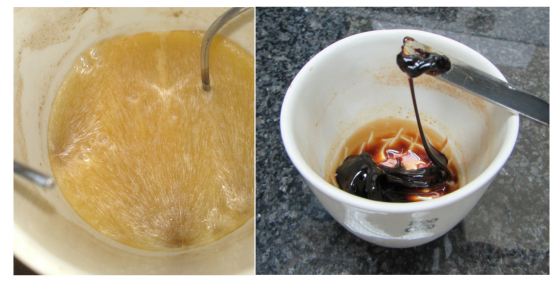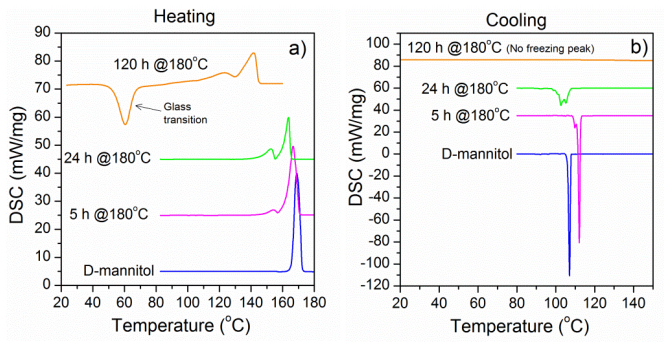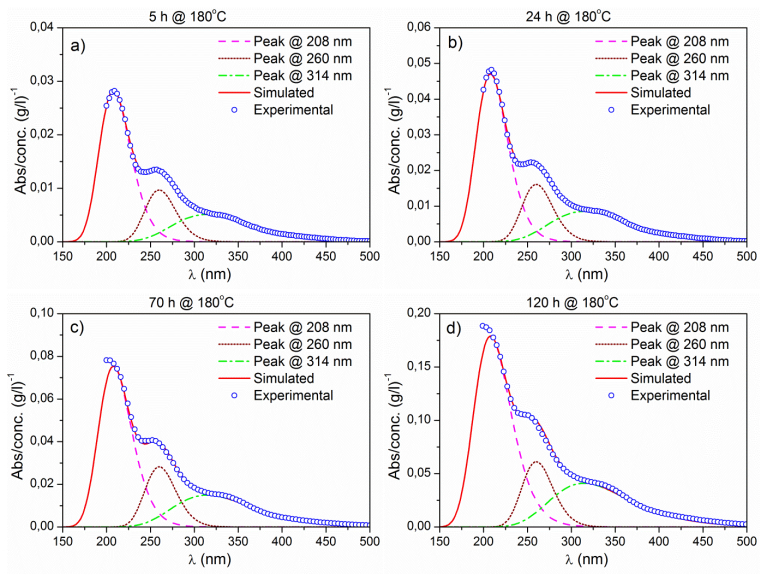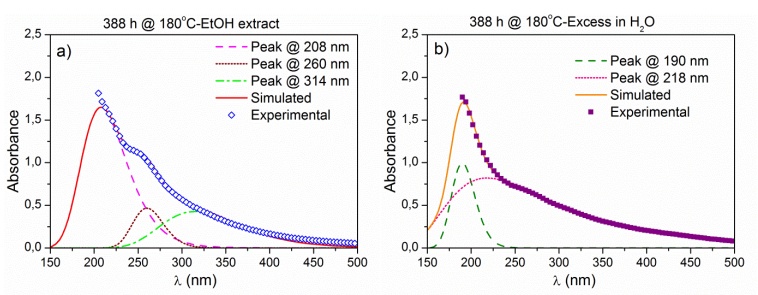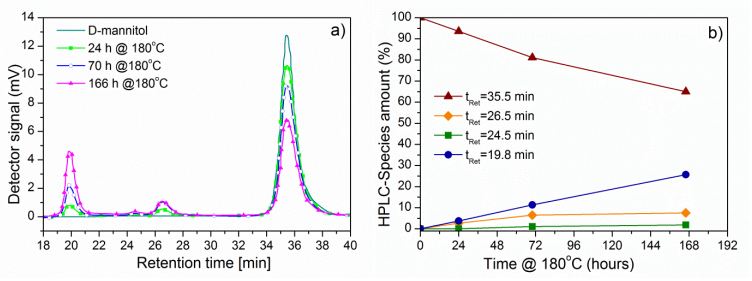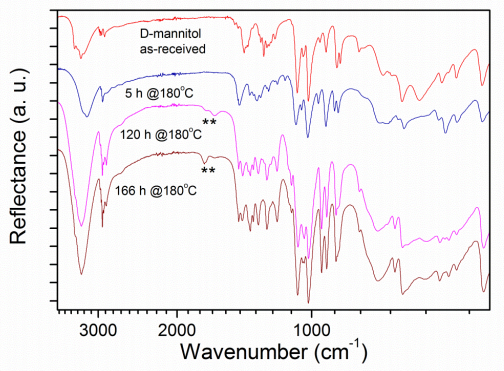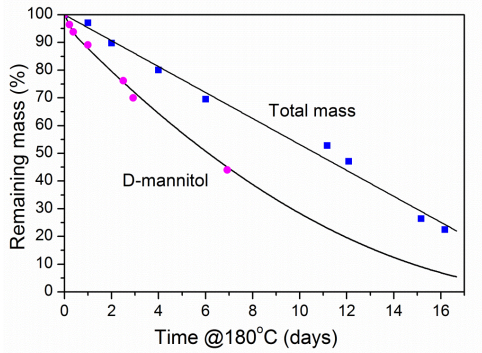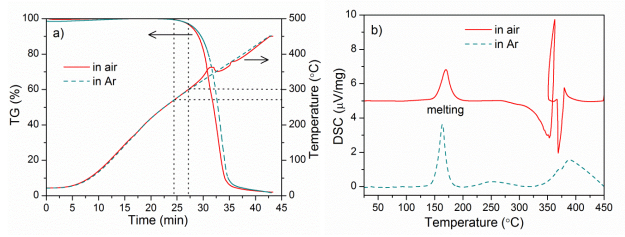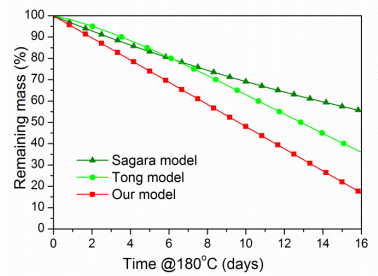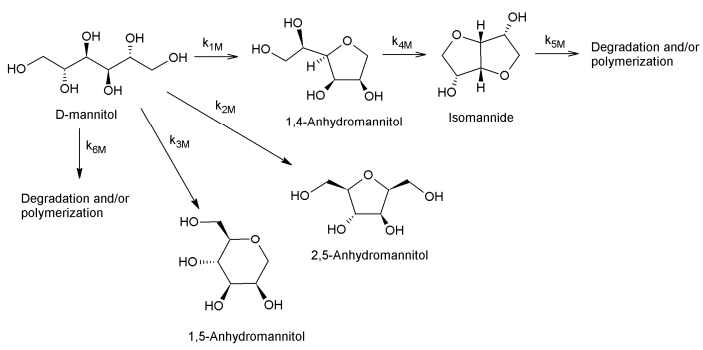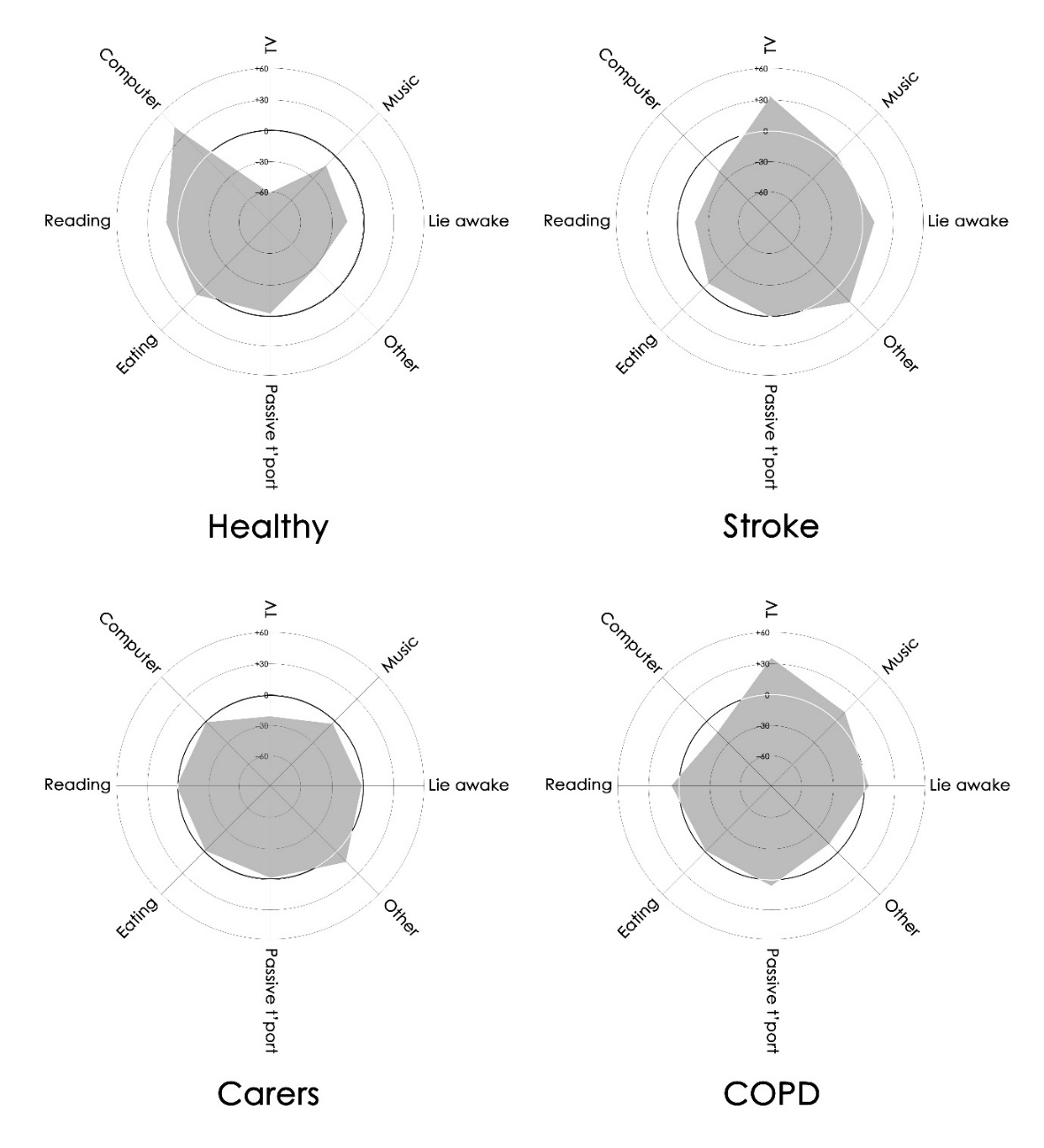1. Introduction
The study of phase change materials (PCMs) has been attracting much attention in the last years since they are among the best options when latent heat from steam wants to be stored. The selection of the most appropriate PCM depends on the steam temperature involved in the process. If we focus in the temperature range 130 ℃–170 ℃, at which many industrial processes and organic Rankine cycles (ORC) take place; a great amount of organic and inorganic compounds have been suggested in the literature [1,2] as good candidates for latent storage in this specific range. One of these compounds is D-mannitol, which is a sugar alcohol of molecular formula C6H8(OH)6 whose six alcoholic groups are arranged in CIS configuration as displayed in the structural formula of Figure 1.
Thermal properties reported for D-mannitol depend on the source. For the case of melting temperature, the values slightly vary from 165 ℃ to 168 ℃ however, for the melting enthalpy, the measured values go from 246 kJ/kg to 338 kJ/kg [3,4,5,6,7,8,9]. Despite these discrepancies such a high value of enthalpy has supported up to now the idea that D-mannitol is one of the most promising PCM candidates for mid-temperature applications since it also has low toxicity, low price and, apparently, good thermal stability [5].
In a previous work [10], we performed differential scanning calorimetry (DSC) measurements of D-mannitol obtaining that melting takes place at 168 ℃ with an enthalpy of 280 kJ/kg, both in good agreement with the data reported in the literature. However we also observed that D-mannitol displayed strong supercooling, which lead to a freezing temperature of 107.7 ℃ and a decrease of phase change enthalpy down to 212 kJ/kg. In that work, thermal behavior of D-mannitol was also studied by performing consecutive melting/freezing cycles inside a furnace under air and it was observed that after 50 melting/freezing cycles, thermal properties of D-mannitol had dramatically changed. Actually a strong color change from white to dark brown was obtained together with a variation of sample consistency from a hard solid to a resinous paste. These changes were confirmed by DSC performed to the sample recovered after 50 cycles for which the melting peak was depleted in two (164 ℃ and 150 ℃) and the enthalpy was decreased to 141 kJ/kg [10]. Taking into account these results, in this work we present a further study of D-mannitol thermal stability in order to confirm that it undergoes strong and fast degradation after melting, which demonstrates that it is not feasible for latent storage application unless it is somehow stabilized.
2. Materials and Methods
D-mannitol used in our experiments was 99% purity technical grade. Differential scanning calorimetry (DSC) measurements were performed using a Perkin-Elmer DSC7 apparatus at heating/cooling rate of 10 ℃/min with samples of about 3 mg encapsulated in aluminum pans. Long-term melting tests of large amounts of D-mannitol (30–40 g) were carried out in ceramic crucibles located inside a conventional furnace with a PID for temperature control. D-mannitol samples were analyzed before and after thermal treatment by visible ultraviolet (Vis-UV) and Fourier-transform infrared (FTIR) spectroscopies together with high performance liquid chromatography (HPLC). Vis-UV spectra of aqueous solutions between 1–20 g/l sample concentration were recorded in the interval 190 nm–500 nm with a Zenyth 200 rt spectrophotometer. FTIR spectra were recorded with a Perkin-Elmer Frontier IR spectrometer with which infrared spectra in solid phase can be directly obtained. HPLC analyses were carried out in two Waters Alliance HPLC systems (Model 2695, Waters Corporation, Milford, MA) with a refractive index detector (RI) (Waters 2414). Some chromatograms were obtained with a CARBOSep CHO-782 column (Transgenomic, Omaha, NE) specially indicated for carbohydrates and sugar alcohols and others with an Aminex HPX-87H column (Biorad) specially indicated for acids and sugar degradation products. In the first case Milli-Q water (Millipore) was used as mobile-phase at 0.5 ml/min with 70 ℃ operating temperature whereas in the second the mobile-phase was 5 × 10–3 M H2SO4 at 0.6 ml/min and 65 ℃. Also thermogravimetric (TG) analyses were performed using a Netzsch STA449 F3 Jupiter Thermobalance with a SiC furnace passing either air or Ar as inert gas at 30 ml/min. The experiments were carried out at increasing temperature from 25 ℃ to 450 ℃ at constant rate 10 ℃/min and during these experiments both mass variation and DSC curves were recorded.
3. Results
From our previous experience [10] we have to say that cycling a PCM subsequently with no stand-by periods does not make too much sense in terms of long-term durability, since melting/freezing cycles should, at least, reproduce the real operating conditions of a PCM in a storage module. Therefore, in order to study thermal stability of a certain PCM, it seems better to perform long-term melting experiments at temperatures 10–20 ℃ above its melting temperature. In this work, D-mannitol samples of about 30–40 g were kept melted inside a furnace under air for different time periods at 180 ℃, i.e. at a constant temperature close-above its melting point. The first thing we observed was that already after 12 h at 180 ℃ D-mannitol color changed from white to yellow (see Figure 2 left), whereas after 166 h (~ 7 days) it became the dark-brown-sticky paste displayed in Figure 2 right which neither froze nor became a hard solid even at ambient temperature.
Not only sample deep browning but also consistency change occurring after only 7 days of melting at 180 ℃ under air clearly indicate that D-mannitol undergoes a strong and fast degradation. In order to clarify which processes take place during D-mannitol thermal degradation, characterization techniques like DSC, HPLC, Vis-UV and FTIR spectroscopies have been applied for detecting possible reaction products. Moreover, mass variation studies for samples kept melted in a crucible together with TG analysis with a thermobalance have been carried out for having an idea of the reaction kinetics of such degradation.
3.1. DSC measurements
DSC measurements were performed for D-mannitol as-received and also for samples kept at 180 ℃ under air during 5 h, 24 h and 120 h. The corresponding second heating and cooling DSC scans are displayed in Figure 3a and Figure 3b. The first thing we observe for all the samples is a strong supercooling, which leads to a freezing temperature about 60 ℃ lower that the melting temperature. Supercooling during freezing has also been reported by several authors not only for D-mannitol but also for other sugar alcohols [11]. The occurrence of such phenomenon is already a serious problem which implies that the difference between charge and discharge temperature for a storage system containing a PCM of this type will be much larger than expected.
On the other hand, as we can see in Figure 3a, as thermal treatment time is increased, D-mannitol melting peak initially appearing at 168 ℃ shifts towards lower temperatures together with the occurrence of a new peak at even lower temperature. Moreover the whole melting enthalpy is strongly decreased from 280 kJ/kg for the as-received D-mannitol to 199 kJ/kg when it is kept 24 h at 180 ℃ and to 95 kJ/kg after 120 h. As for the evolution of the cooling scans (Figure 3b), the single peak displayed by as-received D-mannitol at 107 ℃ is depleted into various peaks which surprisingly disappear in the sample kept melted during 120 h. This means that the sample does not undergo liquid to solid crystallization but a glass transition with no enthalpy change [12]. The fact that a glass transition is taking place can be clearly observed in the heating curve of this sample (see Figure 3a), in which an unexpected exothermic peak appears at around 60 ℃. This peak corresponds to the crystallization of the amorphous glass phase formed during the precedent cooling. Glass transitions occur in amorphous materials, or in amorphous regions within semicrystalline materials, and they correspond to a change from a molten or rubber-like state into a hard and relatively brittle state. They are second order phase transitions and take place slowly and almost with no enthalpy variation. This is why no freezing peak is observed during DSC cooling of D-mannitol sample kept melted for 120 h (see Figure 3b). In our case, the occurrence of a glass transition also agrees with the rubber-like appearance of the samples kept for long time at 180 ℃ showed in Figure 2 (right). As will be discussed in the next section the observed glass transition can be associated to the presence of polymeric species that are expected to be formed when D-mannitol is kept for a certain time at temperatures above the melting point.
3.2. Vis-UV measurements
Although D-mannitol does not present any absorbance in the Vis-UV range, the products leading to the sample browning might be active in this wavelength interval. Therefore, samples from D-mannitol kept at 180 ℃ under air for different times were dissolved in water and their Vis-UV absorption spectrum was recorded in the interval 190 nm–500 nm. Vis-UV absorption spectra are related to species concentration through the Bourger-Lambert-Beer equation in which the absorbance, A (λ), is proportional to molar concentration of the absorbing species, c (in mol/l), the path length, d (in cm), and the extinction coefficient, ε(λ):
Unfortunately, in our case we do not know the concentration of the absorbing species and we only know the total mass concentration (mtotal/V in g/l) of the solution from which the spectrum is recorded. The molar concentration of a certain absorbing species can be expressed as:
Where %wabs is the mass percentage of the absorbing species in the sample and MW is its molecular weight. If we include (Eq.2) in (Eq.1), we can normalize the spectra of all samples dividing absorbance curves by sample concentration (mtotal/V) and taking into account that in our case d is the cuvette size, which is 1 cm. Thanks to this normalization we can compare the evolution of absorbing species from one sample to another.
|
AN(λ)=A(λ)mtotalV=ε(λ)%wabs100×MW
|
(3)
|
Normalized Vis-UV absorption spectra of brown D-mannitol samples could be deconvoluted in three Gaussian peaks at 208 nm, 260 nm and 314 nm after pure D-mannitol curve was subtracted as baseline and abscise axis was changed to wavenumber in cm–1
[10]. In Figure 4 the normalized absorption spectra, represented vs. wavelength in nm, of samples kept at 180 ℃ under air for 5 h (a), 24 h (b), 70 h (c) and 120 h (d) are displayed together with their corresponding deconvolution in the three absorption peaks mentioned above.
It is clear that the intensity of the Vis-UV spectrum increases as D-mannitol is kept for longer times at 180 ℃ under air (note that ordinate scale is different for each sample). This means that the amount of absorbing species (one or more) also increases. It must be pointed out here that we considered only three peaks for the spectra deconvolution because we chose the simplest case that fitted the experimental results. However there could be more absorption peaks contributing to the whole absorption spectrum. On the other hand, since we do not have any clue about the absorbing spices present in the solution, we cannot be sure if the peaks correspond to one or more different species, since one single compound could also display various absorption peaks.
As will be discussed in the next section, the species responsible for these absorptions could be some brown polymeric species similar to the ones formed during sugar caramelization [13]. Some authors claim that these polymeric species might have different solubility in water and ethanol [14]. Therefore, the solubility in ethanol was tested for the samples with the deepest brown color, i. e., the samples kept at 180 ℃ in air for 166 h and 388 h. In both cases we observed that part of the sample was dissolved in ethanol leading to a colored solution that was also measured in the Vis-UV spectrophotometer. The spectrum displayed in Figure 5a corresponds to the ethanol solution of the sample kept 388 h. This spectrum can again be deconvoluted in the same three peaks used for the samples dissolved directly in water. For this sample the remaining solid was further dissolved in water and the corresponding Vis-UV spectrum is displayed in Figure 5b. In this case the spectrum could be deconvoluted in two peaks: one with maximum at 190 nm and another with maximum at 218 nm. These results might be an indication that at least two kinds of absorbing species are present in D-mannitol samples after thermal treatment and that the spectra of the samples dissolved directly in water could have been deconvoluted in more than three peaks.
3.3. HPLC measurements
D-mannitol can be detected by HPLC and so could be the products formed upon thermal treatment provided a separation column specially indicated for carbohydrates and sugar alcohols (i. e. CARBOSep CHO-782) is used. In this way HPLC chromatograms of D-mannitol before and after 8 and 50 melting/freezing cycles were already presented in a previous work [10]. In these chromatograms, apart from the peak of D-mannitol, two new peaks appeared which could not be associated to any species related to sugar degradation. In this work we also applied HPLC to analyze some of the samples kept melted at 180 ℃ in air for different times. In Figure 6a the chromatograms corresponding to as-received D-mannitol and to samples kept at 180 ℃ in air for 24 h, 70 h and 166 h are displayed.
Again we can observe the same two peaks at retention times 26.5 min and 19.8 min, which were obtained for cycled samples [10] and also a new one at 24.5 min that appears after 70 h. This means that at least three non-volatile compounds are formed when D-mannitol is kept melted at 180 ℃. Since not all compounds have the same response at the RI detector, HPLC technique can be used quantitatively only if calibration curves are constructed for each of them. Therefore in our case only estimation in terms of relative amount of detected species through the corresponding peak areas could be made. The results for the analyzed D-mannitol samples are recorded in Figure 6b. The first thing we observe is that the amount of D-mannitol decreases almost linearly with time after about 70 hours (~ 3 days). As for the other species, the one with 19.8 min retention time displays a linear and also the highest formation rate, whereas the amount of the others does not increase so quickly and seems to stabilize with time. This may indicate that not all products are formed from the beginning of the thermal treatment either because they start forming after a certain time or some initial products convert into others as time goes by. If we extrapolate the variation of D-mannitol amount towards longer times, we obtain that it should have completely disappeared from the sample melted at 180 ℃ in air after about 552 h (23 days).
It is possible that some of the products formed during thermal treatment are not separated by the CARBOSep CHO-782 column and hence do not appear in the chromatograms of Figure 6a. Hence D-mannitol samples were further analyzed by using an Aminex HPX-87H column, which is intended for carboxylic acids and can also detect sugar degradation products such as hydroximethyl furfural (HMF) and hydroxyacetyl furan (HAF). In these chromatograms again three peaks were observed and none of them could be associated to HMF or HAF nor to any acidic species. Therefore if we take into account that the RI detector is able to detect species concentration down to 100 ng/l, we can assume that only three non-volatile products are formed when D-mannitol is kept melted at 180 ℃.
3.4. FTIR measurements
Infrared (IR) spectra in solid state were recorded for D-mannitol before and after being kept melted at 180 ℃ under air for different times. As previously reported by several authors, IR spectrum of D-mannitol strongly changes already after the first melting/freezing cycle since the commercial β-phase is converted in the α-phase after recrystallization of the melt [9]. This change can be clearly seen in the IR spectra displayed in Figure 7 if we compare the spectrum of as-received D-mannitol and the corresponding to the sample melted for 5 h.
The other IR spectra recorded in Figure 7 show that D-mannitol samples kept melted for longer times present almost the same spectrum as the 5 h sample but for two new peaks that appear in the range 1730 cm–1–1645 cm–1 (marked with *). These peaks can be associated to the presence of CO double bonds (i. e. carbonyl groups) and some authors claim that this is an indication of alcoholic group oxidation [11]. However as will be discussed in section 4, it is more likely that the occurrence of CO double bonds is a result of the dehydration reactions that are expected to take place when D-mannitol is kept melted for long times.
3.5. Mass variation and TG analyses
Mass variation of some D-mannitol samples kept melted at 180 ℃ in air was monitored as well by taking out the crucible from the furnace and weighing the sample before putting it back inside. The results are displayed in Figure 8 where we can see that the total mass (upper data and line) decreases almost linearly attaining 20% after 16 days (~ 388 h). This strong mass loss clearly indicates that in addition to sample browning a great amount of volatile species are produced during the time D-mannitol is kept above the melting temperature. On the other hand, if we combine mass loss measurements with the HPCL results of estimated D-mannitol mass decrease, we obtain the white points and can construct the downer line of Figure 8.
This line shows that after 16 days we can expect that only 5% initial D-mannitol mass remains and the rest of the sample (15%) mostly contains degradation products. It is not sure what would happen if D-mannitol were kept at 180 ℃ in air more than 16 days since our experiments did not last longer. Either mass loss would stop since no more D-mannitol is available or it would continue if the remaining species would react further producing more volatile compounds. However, even in no more mass loss happened more reactions could still take place in the samples leading to changes in composition and/or to the formation of new products. In a first approach we could think that mass decrease is due to water loss but as will be discussed in next section, not only dehydration reactions but condensations and polymerizations take place during D-mannitol thermal treatment. Actually, if only water was lost, final remaining mass would be 40% whereas Figure 8 clearly shows that only about 20% initial mass remains after 16 days of melting. This means that also carbon containing compounds are evolved while D-mannitol is kept melted even at 180 ℃, which is very close to its solid-liquid transition temperature.
In order to obtain more information about thermal degradation of D-mannitol, thermogravimetric analyses were performed under either Ar or air atmosphere. In these experiments D-mannitol samples were heated from room temperature up to 450 ℃ and both mass loss in percentage (i.e TG) and DSC curves were recorded. In Figure 9a) TG (%) and sample temperature curves plotted vs. time are displayed. As we can see, D-mannitol remains stable under both atmospheres until around 270 ℃ from which it starts loosing mass. Similar stability temperature values were obtained by other authors [3,15] when they performed TG experiments for D-mannitol at 10 ℃/min under N2. Mass loss curves for both atmospheres follow the same behavior until temperature reaches 300 ℃. From that moment, the sample heated under air undergoes a higher mass decrease but also its temperature increases faster than the programmed rate (10 ℃/min). The reason for this sudden temperature increase in the presence of air is that D-mannitol decomposes due to an exothermic combustion process that heats up the sample and rises its temperature.
These differences in D-mannitol decomposition depending on the atmosphere in which it is heated can also be observed in DSC curves plotted vs. sample temperature in Figure 9b. Whereas under Ar this decomposition is an endothermic process starting at around 320 ℃, in air atmosphere this decomposition starts a bit earlier (~ 300 ℃) as an exothermic process which increases sample temperature and is the reason why a loop is observed in DSC curve.
Therefore TG measurements show that although D-mannitol thermal decomposition does not proceed in the same way under air or Ar, significant mass loss always starts above 270 ℃. These results agree with the ones reported by some other authors [3,15] who also performed TG analysis to D-mannitol. However they are in disagreement with the strong mass loss displayed by D-mannitol when it is kept melted in a furnace at 180 ℃ for various days (see Figure 8). This means that TG analysis at increasing temperature may not give us enough information about thermal degradation of a PCM and hence for predicting its long-term durability as storage material.
4. Discussion
In principle D-mannitol decomposition should not be expected upon melting. Actually, for some authors D-mannitol undergoes thermodynamic melting and hence can be melted and recrystallized successively, with no chemical changes between both solid and liquid phases [4]. However thermal degradation studies of D-mannitol performed by thermogravimetric (TG) analysis have been already reported in the literature but still with rather contradictory results. While Kumaresan et al.
[3] obtained that D-mannitol was stable up to 300 ℃, Gallegos et al. [5] observed that it started losing mass already at 235 ℃. In the TG experiments of Anastasakis et al. [16] D-mannitol lost weight from 220 ℃ although most volatile matter was evolved between 250 ℃ and 400 ℃. In contrast, Lee et al. [4] detected a small but gradual weight loss beginning at 120 ℃, which they attributed to a slow sublimation of D-mannitol.
Studies of thermal degradation kinetics of D-mannitol have been reported by different authors too. Sagara et al. [17] evaluated degradation kinetics of D-mannitol at constant temperature above melting point by monitoring the variation of latent heat using DSC, while Tong et al. [15] studied its decomposition under non-isothermal conditions through mass loss measurements obtained from TG analysis performed at different heating rates. The degradation can be described with the general equation:
Where α is de conversion degree, g (α) is the conversion function, t is the time and k is the kinetic constant whose expression is:
For Sagara et al. [17] D-mannitol undergoes a first order degradation so that (Eq. 4) leads to:
Whereas Tong et al. [15] suggest a Šesták-Berggren kinetic model [18] with the following function g (α) to be included in (Eq. 4), which has to be further integrated in α:
|
g(α)=α0.306(1−α)0.381
|
(7)
|
Although these authors performed kinetic studies in different ways, they obtained quite similar values for the activation energy and the pre-exponential factor: Ea = 117–120 kJ/mol and lnA = 16–18. In contrast, our experiments show a linear decrease of D-mannitol mass with time (see Figure 8), which means that kinetics should be of zero order and hence governed by the equation:
D-mannitol remaining mass percentage can be expressed in terms of conversion degree:
|
Remainingmass[%]=100(1−α)
|
(9)
|
The value of the kinetic constant obtained from the linear fitting of our experimental results displayed in Figure 8 (upper line) is 5.416 × 10–7 (s–1) and if we apply the values of Ea and A calculated by Sagara et al. [17] and Tong et al. [15] we obtain T = 183 ℃ and T = 174 ℃ respectively. Both temperature values are in perfect agreement with the temperature at which mass loss experiments were performed. Therefore, kinetic parameters seem to be the same although the kinetic models are different. In Figure 10 we have compared the time variation of D-mannitol remaining mass (Eq. 9) obtained using our model (Eq. 8) with the expected values calculated with the kinetic equations of Sagara et al. [17] (Eq. 6) and Tong et al. [15] (Eq.7).
According to our model, D-mannitol mass decreases much faster than predicted by the other two models. This is not very surprising since kinetic studies Sagara et al. of were based on DSC results performed under Ar [17] and Tong et al. kinetics were obtained from TG measurements in N2 [15]. Actually, in our TG measurements (see Figure 9) we have observed that D-mannitol decomposition takes place through different reaction mechanisms depending on whether it is carried out under Ar or under air atmosphere. Therefore to our opinion, it would be more reliable to perform TG measurements by keeping D-mannitol melted at various constant temperatures in order to determine the kinetics of its degradation under conditions closer to its real operation in the storage system.
On the other hand, for calculating the conversion degree in (Eq.9) we have considered the remaining total mass (i. e. upper line of Figure 8), which includes not only D-mannitol but also other solid products formed during degradation. However, as displayed by the downer curve of Figure 8, the amount of pure D-mannitol that remains is the sample is lower and hence the conversion degree (α) considered in the kinetic calculations should be higher. These results prove that D-mannitol thermal degradation is a complex process in which not only solid to gas but also solid to solid reactions take place. Therefore mass loss studies are not enough and they should be combined with other analytical techniques if the kinetics of this process want to be determined.
In this way we found in the literature that Yamaguchi et al. also performed kinetic studies of D-mannitol at temperatures between 250 ℃ and 300 ℃ in hot water under Ar atmosphere [19]. The aim of these authors was to achieve intramolecular dehydration without adding any hazardous acid catalyst. Intramolecular dehydration mechanism of D-mannitol (and in general of sugar alcohols) is quite complicated since a lot of products can be produced under competitive reaction paths. Figure 11 displays the scheme proposed by Yamaguchi et al. for the reaction pathway of D-mannitol dehydration under hot water with not acid catalyst [19].
In their kinetic studies, Yamaguchi et al. obtained a mixture of soluble and insoluble products which were separated by filtration. The water soluble products together with the remaining D-mannitol were analyzed by HPLC. For the lowest temperature studied (250 ℃) they found that after 35 h, 10% D-mannitol remained unreacted and 2, 5-anhydromannitol (39.5%) and 1, 4-anhydromannitol (25.5%) were the major products with 1, 5-anhydromannitol and isomannide each of them only yielding 6%. We suppose that the 13% missing in the mass balance should correspond to the insoluble products that were not analyzed, to volatile compounds that are not mentioned or to both. From their dehydration studies Yamaguchi et al. calculated the Arrhenius equation of all the kinetic constants displayed in the scheme of Figure 11. The corresponding activation energies vary from 135 kJ/mol for path k3M to 196 kJ/mol for path k6M, although the largest kinetic constant is k2M which makes 2, 5-anhydromannitol to be the major dehydration product.
Again we extrapolated the kinetic calculations of Yamaguchi et al. [19] to 180 ℃ in order to see whether they fitted our experimental results. According to their model 93% D-mannitol should remain after 10 days whereas our results indicate that only 48% initial D-mannitol mass remains in the sample (see Figure 10). This means that thermal degradation of D-mannitol proceeds much faster than its dehydration in water at high temperatures. Of course we cannot expect that both processes are produced in the same way but still the results of Yamaguchi prove that D-mannitol undergoes dehydration at high temperatures and if the process takes place in water it could take place as well, and probably at more extent than when water is not present. Also the reaction paths displayed in the scheme of Figure 11 indicate that, apart from anhydromannitol isomers, other undefined compounds, such as degradation products and/or polymers, are expected to be formed upon heating. Actually the formation of polymeric species as degradation product of D-mannitol due to thermal treatment is a possibility that will be further discussed along this section.
In relation to D-mannitol color change, some previous studies have shown that D-mannitol becomes brown when kept for several hours at temperatures close to its melting point [20] or subjected to melting/freezing cycles [11]. As shown in the section 3, we also observed a strong color change from white to deep brown of D-mannitol samples after melting/freezing cycles [10] and when kept melted at 180 ℃ for a certain time under air (see Figure 2). As already said, such a strong color change is a clear indication that, unfortunately, D-mannitol undergoes degradation upon thermal treatment.
This degradation was confirmed by DSC scans in which not only a decrease in both melting temperature and melting enthalpy was obtained but the occurrence of a glass transition was observed (see Figure 3). The decrease in latent heat values has been already reported by Sagara et al. when they performed long-term DSC experiments keeping D-mannitol melted at constant temperature for their kinetic studies [17]. However, up to now, nothing has been said about the occurrence of glass transitions in D-mannitol although sample browning has been observed in some cases [11,20].
Attempts to improve thermal stability of D-mannitol upon melting have been carried out by some authors. With this aim Wu et al. prepared D-mannitol@silica core-shell microcapsules [21] for which thermal behavior was studied by DSC. Unfortunately these microcapsules displayed irreversible phase change processes probably due to a reaction between melted D-mannitol and some of the functional group present in the silica shell. Sagara et al. [17] also tried to improve thermal endurance of D-mannitol by its impregnation into nano-sized pores of SiO2 particles. These authors obtained that the stability of D-mannitol in nanopores was improved so that thermal degradation period was 13 times longer than that of the pure D-mannitol. However if we compare with our degradation results this would mean that for losing 80% mass, D-mannitol impregnated in SiO2 nanopores would require 208 days instead of 16 days. In other words it would last 7 months and not half a month, which does not represent any significant improvement from the practical point of view if D-mannitol wants to be implemented as PCM in a thermal storage system.
With the aim of avoiding thermal degradation we also performed in our lab melting/freezing cycles and long-term melting experiments of D-mannitol under inert atmospheres such as Ar and N2 [22]. Unfortunately in this case, strong browning was also observed after 16 days in addition to a change in sample appearance to a soft-sticky paste and a decrease of initial mass. Hence the results obtained in our recent work [22] clearly demonstrate that D-mannitol is unstable after melting even under inert atmosphere.
To our opinion the browning displayed by D-mannitol upon thermal treatment can be associated to caramelization processes similar to those that usually take place when sugars are heated and during which they turn from white to brown color [13]. Sugar caramelization is a poorly understood process in which different complex reactions take place and many kinds of products are formed. It usually starts with dehydration during which three water molecules are lost giving place to either hydroxymethyl furfural (HMF) or hydroxyacetyl furan (HAF) depending on the sites at which dehydration occurs. Apart from HMF and HAF, various volatile species are also formed, which give burnt sugars their characteristic acrid smell, together with cyclic compounds responsible for the caramel flavor [13,14]. Other reactions that take place during caramelization are condensations and polymerization processes which produce highly colored species with high molecular weights. These products are amorphous carbohydrates that might form colloidal solutions and that still contain some alcoholic groups together with carbonyl groups (aldehydes or ketones) [14,23].
As we can see, a wide spectrum of products is formed during sugar caramelization, mainly volatile species and colored compounds of polymeric nature. Hence, if we assume a similar behavior of D-mannitol upon thermal treatment, both volatile compounds and colored degradation products might be expected as well. In relation to the analysis of volatile species produced during D-mannitol heating we did not perform any experiment. However Anastasakis et al. [15] did analyze the volatile species evolved from D-mannitol when they carried out TG experiments. They observed that the generation of volatile compounds from the pyrolysis of D-mannitol took place above 400 ℃ with the evolution of cyclic compounds such as furan, 2-propylfuran and dianhydromannitol (also called isomannide in Figure 11). In our experiments we never attained such high temperatures but still a strong mass loss was obtained for samples kept at 180 ℃ under air (see Figure 8). Again this means that even at temperatures close to melting point volatile species are evolved and that only performing TG experiments at increasing temperature is not enough to get information about thermal stability of D-mannitol after melting.
On the other hand, Yamaguchi et al. [19] also detected the presence of isomannide (or dianhydromannitol) as dehydration product of D-mannitol after 10 h at 250 ℃, although in their case it was not evolved but stayed dissolved in the aqueous reaction medium. This proves that this compound could be formed at temperatures much lower than 400 ℃ if D-mannitol is kept melted for enough time and hence it can be evolved from the sample since dehydration does not take place in aqueous solution.
For investigating D-mannitol degradation products remaining in the samples we applied various characterization techniques such as DSC, Vis-UV spectroscopy, HPLC and FTIR spectroscopy. In DSC measurements (see Figure 3), apart from a decrease in melting temperature and enthalpy, a glass transition was observed if samples were kept melted at 180 ℃ in air longer than 120 h (5 days). If we take into account that caramelized sugars also display glass transitions [24] due to the presence of the amorphous polymeric species mentioned above, our DSC results point out to the formation of some kind of polymeric compounds during D-mannitol thermal treatment, which also agrees with the sticky consistency displayed by samples kept melted for long time.
In relation to Vis-UV spectra, caramelized sugars usually present various absorbance maxima. Actually both HMF and HAF display absorption in the Vis-UV range since they contain α-β unsaturated carbonyl groups. HMF displays two main absorptions at 284 nm and 230 nm [25] whereas HAF main absorptions appear at 275 nm and 225 nm [26]. Additional absorptions at larger wavelengths (~ 420 nm) are observed in caramel solutions that are usually associated to high molecular weight molecules (i.e. polymers) and hence can be used as an indicator or the amount of large molecules in the product mixture. Thanks to these absorptions some authors have monitored the extent of caramelization by simply using Vis-UV spectra [24].
In the case of D-mannitol we also observed strong absorption in the Vis-UV range for the samples kept melted in air at 180 ℃ (see Figure 4). However the deconvoluted peak maxima did not match the wavelength values corresponding to the products of sugar caramelization mentioned above, although the range is quite similar. This is not surprising since HPLC analysis confirmed that neither HMF nor HAF were present in D-mannitol samples after thermal treatment. In any case we should not expect that D-mannitol caramelization leads to exactly the same products as sugar caramelization since the original compounds are not equal and D-mannitol should have its own caramelization products. Other compounds that contain α-β unsaturated carbonyl groups like for example 4-methylpent-3-en-2-one [27] display absorption bands between 240 nm and 320 nm which could be an indication that the degradation products of D-mannitol contain this kind of functional group. As discussed in section 3.2 we only considered three peaks for deconvoluting the Vis-UV spectra (see Figure 4) but there could be more absorption peaks contributing to the whole absorption spectrum. This seems to be confirmed by the spectra of the ethanol solution and the water solution of the undissolved solid (see Figure 5), which can point out to the presence of different kinds of brown polymeric species some of them soluble in ethanol and some of them only soluble in water. In any case, even if the absorbing species are not identified, we can conclude that some of them have polymeric nature and might contain α-β unsaturated carbonyl groups.
With HPLC analyses performed for water solutions of D-mannitol samples kept melted at 180 ℃ in air, we detected three degradation products (see Figure 6a). Jian et al. monitored the extent of sugar caramelization by means of HPLC [24] since HMF can be easily detected and HPLC allows quantitative analysis provided a previous calibration is made. However, as discussed in section 3.3, these compounds were not detected as thermal degradation products of D-mannitol. The only data found in the literature about HPLC performed to D-mannitol samples after thermal treatment are reported by Lee et al. [20] and Yamaguchi et al. [19]. Lee et al. analyzed samples being kept in a DSC apparatus for various days close to the melting point under N2 and they observed that, in addition to sample browning, two kinds of unidentified decomposition products amounting 1.49% were detected. Yamaguchi et al. analyzed and quantified D-mannitol products after dehydration in water at temperatures between 250 ℃ and 400 ℃ by comparing with the retention times of the standard materials [19].
Therefore it seems that D-mannitol degradation products can be detected by HPLC technique using separation columns for sugars, although for identifying them a calibration with the expected compounds is required. Unfortunately when we performed our HPLC measurements wet did not have any clue about the kind of products that could be present in the degraded D-mannitol samples and we could make calibration curves. Hence as we said in section 3.3 we can be almost sure that only three non-volatile products are formed when D-mannitol is kept melted at 180 ℃ and that these species could be separated and maybe identified through other characterization techniques for organic compounds, like for example, nuclear magnetic resonance (NMR).
As for the solid state IR spectra of D-mannitol after being kept melted for a certain time, apart from the typical pattern change due to the conversion of β-phase in α-phase upon recrystallization [9], two new peaks were detected in the range 1730 cm–1–1645 cm–1. Other authors, like Solé et al.
[11], also observed the occurrence of IR peaks at similar wavenumbers after D-mannitol thermal treatments. Since this vibration zone corresponds to C=O groups present in ketones, aldehydes or acids, they suggested that D-mannitol degradation is due to its oxidation under air. It is true that CO double bond groups (aldehydes/ketones) are the next oxidized species from alcoholic groups, however we do not think that the formation of CO double bonds is due to the oxidation of D-mannitol alcoholic groups. Actually for oxidizing alcoholic groups in organic molecules strong oxidants like permanganate or dichromate are usually required [28,29]. If we have a look to the characterization studies reported in the literature for the caramelization products of sugars, we can find that IR spectra of the polymeric species formed during the process closely resemble the corresponding spectra of the initial sugars [14]. This means that the essential structural features of all those compounds remain unchanged. However they all present two additional bands at 1707 cm–1 and 1663 cm–1 that correspond to C=O vibrations of ketonic and enolic functional groups respectively [14]. A similar behavior is observed for IR spectra of D-mannitol samples kept melted under air, which display almost the same vibration pattern after 5 h, 120 h and 166 h but for the two new vibration bands at 1730 cm–1 and 1645 cm–1 (see Figure 7). It is interesting to note that hydrocarbons with α,
β-unsaturated carbonyl groups also display two bands in the same region [30] and hence this kind of organic structures could be also present in the polymeric degradation products of D-mannitol.
Therefore, to our opinion, the formation of CO double bonds is a result of the degradation reactions that take place in melted D-mannitol, which are not oxidations but dehydrations, condensations and polymerizations. Actually if we take into account the scheme proposed by Yamaguchi et al. [19], thermal dehydration of polyalcohols can give place to the formation of cyclic ethers (see Figure 11) but also to other products formed through reaction pathways similar to the displayed in Figure 12. In such case, thermal dehydration would produce alkenols (or enols) groups, which are reactive structures represented as an alkene (olefin) with a hydroxyl group attached to one end of the alkene double bond. Enols can convert into ketonic groups which can be further dehydrated and condensed (i.e. through the so-called aldolic condensation) and give place to the α, β-unsaturated carbonyl (or enones) groups whose bands are observed in FTIR spectra of D-mannitol samples after thermal treatment.
5. Conclusion
In this work we studied the behavior of D-mannitol when it is kept melted for a certain time at 180 ℃, which is a temperature only 15 ℃ above its melting point in order to see its feasibility in a commercial latent storage module. The first thing observed was that after only 7 days at 180 ℃, D-mannitol was converted into a dark-brown-sticky paste which did not solidify upon cooling. Moreover, when D-mannitol was kept melted at 180 ℃, a strong mass decrease was obtained so that 80% initial sample was lost after 16 days. This means that not only water but also carbon containing volatile species were produced during this time. Sample browning, consistency change and mass decrease are clear indicators that D-mannitol undergoes strong degradation when kept melted at 180 ℃ for a certain time.
After a deep literature review we concluded that the browning displayed by D-mannitol upon thermal treatment could be associated to caramelization processes similar to those that usually take place when sugars are heated. Caramelization is a complex process that involves many kinds of reactions such as dehydrations, condensations and polymerizations during which a great variety of volatile and non-volatile compounds are formed. In this way, various characterization techniques like DSC, HPLC, Vis-UV and FTIR spectroscopies and TG analysis were applied in order to have an idea of the kinetics and possible reaction products of D-mannitol thermal degradation.
From the kinetic point of view we observed that thermal degradation of D-mannitol proceeded much faster than predicted by the models found in the literature. These models were obtained from studies performed in a DSC apparatus by monitoring changes in melting enthalpy with time or from TG measurements under increasing temperature by monitoring mass loss. To our opinion these techniques are not adequate enough for predicting D-mannitol degradation under real operation conditions in a storage system. Our proposal is that mass loss studies at constant temperature with analysis of evolved products would be more adequate and they should be combined with the analysis of the remaining solid by means different techniques. Actually this kind of TG measurements should be applied to any other PCM for which thermal degradation wants to be studied; especially if we are dealing with organic compounds.
In relation to the analysis of D-mannitol degradation products, HPLC results point out to the formation of three products some of which are expected to be brown polymeric species. The presence of polymeric compounds seems to be confirmed by DSC scans which clearly show the occurrence of a glass transition. These polymeric species probably contain carbonyl groups, enolic groups or α,
β-unsaturated carbonyl groups, which might be responsible for the strong absorption in the 200 nm–500 nm of the Vis-UV spectra and the two bands at 1730 cm–1 and 1645 cm–1 observed in FTIR spectra. Unfortunately the stoichiometry of D-mannitol degradation products could not be elucidated from the characterization techniques we applied, but it seems that these products could be separated by chromatography and be identified by means other characterization techniques for organic compounds. These results show that D-mannitol thermal degradation is a complex process in which not only solid to gas but also solid to solid reactions take place even at temperatures close to melting point.
As for D-mannitol long-term endurance, our experiments have demonstrated that the studies reported by other authors are misleading since all of them performed consecutive melting freezing cycles in a DSC apparatus under inert atmosphere. However, since these tests are very far from the PCM working conditions in a real storage system, the results obtained cannot be extrapolated and will not be representative of the PCM real behavior. To our opinion reliable melting freezing cycles should be carried out in conventional ovens or calorimeters, with a representative amount of sample and under temperature, time and atmosphere conditions similar to those used when the thermal storage system is under real service. Also it must be taken into account that the PCM long-term endurance cannot be ensured for times longer than the tested.
The main conclusion of our studies is that D-mannitol undergoes strong degradation at temperatures close to its melting point not only under air but also under inert atmosphere. This proves that unless this compound is somehow stabilized (encapsulation, composites, etc) it should not be used as PCM for any latent storage application. Therefore to our opinion this compound should be removed from the lists of PCM candidates drawing our attention with care to other promising PCM candidates, especially of organic nature, for which reliable thermal stability or long-term endurance test have not been performed yet.
Acknowledgments
This work was supported by the European Union through the 7th Frame Program under the REELCOOP Project (grant number 608466). Moreover, the authors would like to acknowledge Biomass Unit of CIEMAT for the HPLC and Vis-UV measurements, especially Dr. Felicia Saez; Alfonso Vidal from Solar Fuels & High Temperature Industrial Processes group for the thermogravimetric experiments and Department of Inorganic Chemistry of University of Valladolid for DSC and IR measurements, especially Emiliano Tritto and María Barcenilla.
Conflict of Interest
All authors declare no conflicts of interest in this paper.










 DownLoad:
DownLoad: 